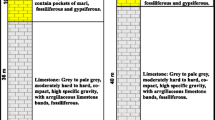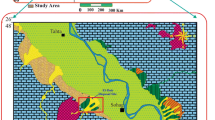Abstract
Groundwater contamination is one of the most significant problems in arid countries. Al-Quwiy’yia region is an example of an area where the groundwater is contaminated as a result of infiltration of waste water in low-lying areas adjacent to inhabited zones. Such contamination poses significant environmental threats for the surrounding environment and groundwater. Surface observations and spatial distribution of contamination observed in the shallow aquifer indicate that the main contamination sources were from sewage as well as from waste water dumping. However, the main source of water supply for the whole area is groundwater abstracted from the relatively shallow aquifer. Therefore, the transient electromagnetic method (TEM) and 2D electrical resistivity tomography (2D ERT) have been applied close to the waste water dump site to characterize the response of pollution plumes. Both of these geoelectrical techniques are sensitive to electrical conductivity as well as to other physical properties, which are greatly influenced by the polluted groundwater. Therefore, it is possible to profile the contamination plumes, both vertically and horizontally, in the vicinity of the measured stations. The ERT profiles gave detailed information about the lateral distribution of the contaminated groundwater, whereas the TEM demonstrated the vertical extensions.









Similar content being viewed by others
References
Al-Saleh MA (1992) Declining groundwater level of the Minjur aquifer, Tebrak area, Saudi Arabia. Geogr J 158:215–222
Applied Electromagnetic Research (AEMR) (2007) TEM-Researcher manual, version 7, The Netherlands, p 49
Asfahani J (2007) Geoelectrical investigation for characterizing the hydrogeological conditions in semi-arid region in Khanasser valley, Syria. J Arid Environ 68:31–52
Auken E, Pellerin L, Sørensen K (2001) Mutually constrained inversion (MCI) of electrical and electromagnetic data. In: Proceedings of annual meeting of the society of exploration geophysics, San Antonio, TX, USA
Barsukov P, Fainberg E, Khabensky E (2006) Shallow investigations by TEM-FAST sounding of the Earth’s interior. In: Spichak V (ed) Methods in geochemistry and geophysics, vol 40. Elsevier, Amsterdam, pp 55–77
Dawson CB, Lane JW, White EA, Belaval M (2002) Integrated geophysical characterization of the Winthrop Landfill southern flow. In: Proceedings of symposium on the application of geophysics to engineering and environmental problems held in Las Vegas, Nevada on February 10–14 2002, Denver, Colorado, Environmental and Engineering Geophysical Society, CD-ROM, p 22
Delgado Rodríguez O, Torres ML, Shevnin V, Ryjov A (2012) Estimation of soil petrophysical parameters based on electrical resistivity values obtained from lab and in-field measurements. Geofisc Int 51:5–15
Griffiths DH, Barker RD (1993) Two-dimensional resistivity imaging and modeling in areas of complex geology. J Appl Geophys 29:211–226
Loke MH (1999) Electrical imaging surveys for environmental and engineering studies. A practical guide to 2D and 3D surveys: Austin, Texas. Advanced Geosciences Inc., USA, p 57
Loke MH (2003) Tutorial: 2-D and 3-D electrical imaging surveys. http://www.geoelectrical.com
Loke MH, Barker RD (1996) Rapid least-squares inversion of apparent resistivity pseudosections by a quasi-Newton method. Geophys Prospect 44:131–152
Madison R, Brunett J (1985) Overview of the occurrence of nitrate in groundwater of the United States. US geological survey water-supply paper 2275; US geological survey: Reston, Virginia
Metwaly M, Khalil MA, Al-Sayed E, El-Kenawy A (2012a) Tracing subsurface oil pollution leakage using 2D electrical resistivity tomography. Arabian J Geosci. doi:10.1007/s12517-012-0600-z
Metwaly M, Elawadi E, Moustafal SSR, Al Fouzan F, Al Mogren S, Al Arifi N (2012b) Groundwater exploration using geoelectrical resistivity technique at Al-Quwy’yia area central Saudi Arabia. Int J Phys Sci 7:317–326
Mueller DK, Hamilton PA, Helsel DR, Hitt KJ, Ruddy BC (1995) Nutrients in ground water and surface water of the United States—an analysis of data through 1992. Water-Resources investigations report 95–4031. US geological survey, Denver, CO
Nabighian MN, Macnae JC (1991) Time domain electromagnetic prospecting methods. In: Nabighian MN (ed) Electromagnetic methods in applied geophysics, part A, vol 2. Soc Expl Geophys 427–509
Nebert K (1970) Geology and western Al Quaway’iah region, Saudi Arabia. N Jb Geo Palaeont Abh 135:150–170
Parasnis D (1997) Principle of applied geophysics. Chapman & Hall, London, p 275
Pellerin L (2002) Applications of electrical and electromagnetic methods for environmental and geotechnical investigations. Surv Geophys 23:101–132
Porsani JL, Bortolozo CA, Almeida ER, Sobrinho EN, dos Santos TG (2012) TDEM survey in urban environmental for hydrogeological study at USP campus in Sao Paulo City, Brazil. J Appl Geophys 76:102–108
Senalp M, Al-Duaiji A (2001) Sequence stratigraphy of the Unayzah reservoir in central Saudi Arabia, Saudi ARAMCO of Technology, Summer, pp 19–43
Telford WM, Geldart LP, Sheriff RE (1995) Applied geophysics. Cambridge University Press, New York
Waxman MH, Smits LJM (1968) Electrical conduction in oil-bearing sands. Soc Petrol Eng J 8:107–122
Yadav GS, Singh SK (2007) Integrated resistivity surveys for delineation of fractures for ground water exploration in hard rock area. J Appl Geophys 62:301–312
Acknowledgments
This work was supported financially by the National Plan for Science, Technology and Innovation (NPST) program, King Saud University, Saudi Arabia (Project No. 09-ENV836-02).
Author information
Authors and Affiliations
Corresponding author
Rights and permissions
About this article
Cite this article
Metwaly, M., Elawadi, E., Moustafa, S.S.R. et al. Groundwater contamination assessment in Al-Quwy’yia area of central Saudi Arabia using transient electromagnetic and 2D electrical resistivity tomography. Environ Earth Sci 71, 827–835 (2014). https://doi.org/10.1007/s12665-013-2485-x
Received:
Accepted:
Published:
Issue Date:
DOI: https://doi.org/10.1007/s12665-013-2485-x




